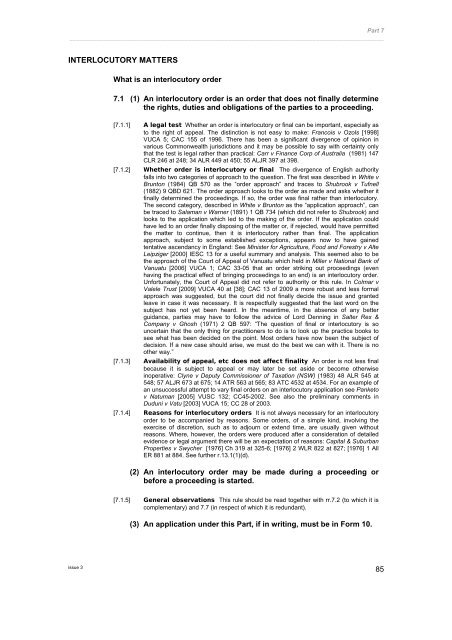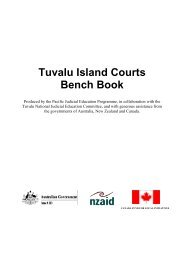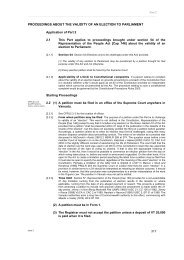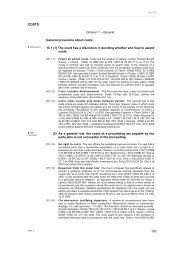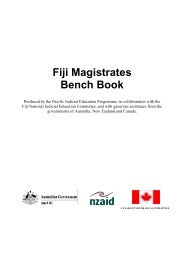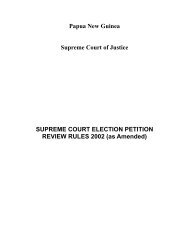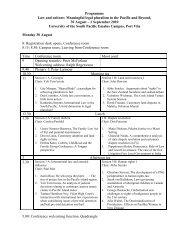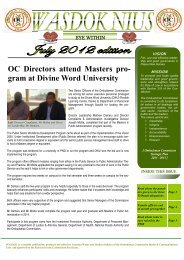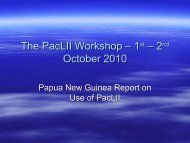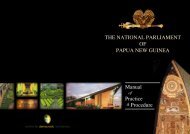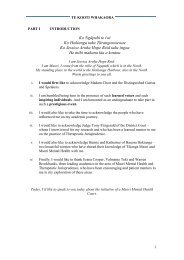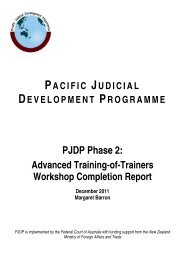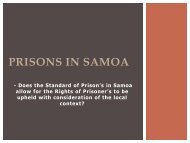Part 7 Interlocutory Matters - PacLII
Part 7 Interlocutory Matters - PacLII
Part 7 Interlocutory Matters - PacLII
You also want an ePaper? Increase the reach of your titles
YUMPU automatically turns print PDFs into web optimized ePapers that Google loves.
<strong>Part</strong> 7<br />
_____________________________________________________________________________________________<br />
INTERLOCUTORY MATTERS<br />
What is an interlocutory order<br />
7.1 (1) An interlocutory order is an order that does not finally determine<br />
the rights, duties and obligations of the parties to a proceeding.<br />
[7.1.1] A legal test Whether an order is interlocutory or final can be important, especially as<br />
to the right of appeal. The distinction is not easy to make: Francois v Ozols [1998]<br />
VUCA 5; CAC 155 of 1996. There has been a significant divergence of opinion in<br />
various Commonwealth jurisdictions and it may be possible to say with certainty only<br />
that the test is legal rather than practical: Carr v Finance Corp of Australia (1981) 147<br />
CLR 246 at 248; 34 ALR 449 at 450; 55 ALJR 397 at 398.<br />
[7.1.2] Whether order is interlocutory or final The divergence of English authority<br />
falls into two categories of approach to the question. The first was described in White v<br />
Brunton (1984) QB 570 as the “order approach” and traces to Shubrook v Tufnell<br />
(1882) 9 QBD 621. The order approach looks to the order as made and asks whether it<br />
finally determined the proceedings. If so, the order was final rather than interlocutory.<br />
The second category, described in White v Brunton as the “application approach”, can<br />
be traced to Salaman v Warner (1891) 1 QB 734 (which did not refer to Shubrook) and<br />
looks to the application which led to the making of the order. If the application could<br />
have led to an order finally disposing of the matter or, if rejected, would have permitted<br />
the matter to continue, then it is interlocutory rather than final. The application<br />
approach, subject to some established exceptions, appears now to have gained<br />
tentative ascendancy in England: See Minister for Agriculture, Food and Forestry v Alte<br />
Leipziger [2000] IESC 13 for a useful summary and analysis. This seemed also to be<br />
the approach of the Court of Appeal of Vanuatu which held in Miller v National Bank of<br />
Vanuatu [2006] VUCA 1; CAC 33-05 that an order striking out proceedings (even<br />
having the practical effect of bringing proceedings to an end) is an interlocutory order.<br />
Unfortunately, the Court of Appeal did not refer to authority or this rule. In Colmar v<br />
Valele Trust [2009] VUCA 40 at [38]; CAC 13 of 2009 a more robust and less formal<br />
approach was suggested, but the court did not finally decide the issue and granted<br />
leave in case it was necessary. It is respectfully suggested that the last word on the<br />
subject has not yet been heard. In the meantime, in the absence of any better<br />
guidance, parties may have to follow the advice of Lord Denning in Salter Rex &<br />
Company v Ghosh (1971) 2 QB 597: “The question of final or interlocutory is so<br />
uncertain that the only thing for practitioners to do is to look up the practice books to<br />
see what has been decided on the point. Most orders have now been the subject of<br />
decision. If a new case should arise, we must do the best we can with it. There is no<br />
other way.”<br />
[7.1.3] Availability of appeal, etc does not affect finality An order is not less final<br />
because it is subject to appeal or may later be set aside or become otherwise<br />
inoperative: Clyne v Deputy Commissioner of Taxation (NSW) (1983) 48 ALR 545 at<br />
548; 57 ALJR 673 at 675; 14 ATR 563 at 565; 83 ATC 4532 at 4534. For an example of<br />
an unsuccessful attempt to vary final orders on an interlocutory application see Panketo<br />
v Natuman [2005] VUSC 132; CC45-2002. See also the preliminary comments in<br />
Duduni v Vatu [2003] VUCA 15; CC 28 of 2003.<br />
[7.1.4] Reasons for interlocutory orders It is not always necessary for an interlocutory<br />
order to be accompanied by reasons. Some orders, of a simple kind, involving the<br />
exercise of discretion, such as to adjourn or extend time, are usually given without<br />
reasons. Where, however, the orders were produced after a consideration of detailed<br />
evidence or legal argument there will be an expectation of reasons: Capital & Suburban<br />
Properties v Swycher [1976] Ch 319 at 325-6; [1976] 2 WLR 822 at 827; [1976] 1 All<br />
ER 881 at 884. See further r.13.1(1)(d).<br />
(2) An interlocutory order may be made during a proceeding or<br />
before a proceeding is started.<br />
[7.1.5] General observations This rule should be read together with rr.7.2 (to which it is<br />
complementary) and 7.7 (in respect of which it is redundant).<br />
(3) An application under this <strong>Part</strong>, if in writing, must be in Form 10.<br />
issue 3 85
<strong>Part</strong> 7<br />
_____________________________________________________________________________________________<br />
E CPR r23.6<br />
E CPR r22<br />
E CPR r23.4(1)<br />
E CPR r23.11<br />
Applying for an interlocutory order during a proceeding<br />
7.2 (1) A party may apply for an interlocutory order at any stage of a<br />
proceeding.<br />
[7.2.1] Meaning of “proceeding” The word “proceeding” is very wide and includes<br />
everything from the moment the court’s jurisdiction is first invoked until final judgment is<br />
enforced or performed: Poyser v Minors (1881) 7 QBD 329 at 334; Re Shoesmith [1938]<br />
2 KB 637 at 648, 652. See further r.7.7(a).<br />
(2) If the proceeding has started, the application must if practicable<br />
be made orally during a conference.<br />
[7.2.2] Manner in which applications to be made The rule is explicit – applications<br />
“must” be made this way. The intent is clearly to reduce filing bulk and dispose of as<br />
much business as possible in one conference (See r.1.4(2)(i)). It is suggested,<br />
however, that all but routine applications should be made upon written notice to avoid<br />
surprise, adjournments and delay. Despite the mandatory words of the rule, it is<br />
common for the court to require a written application in all but the simplest situations.<br />
An application for an order which, if granted, will in substance finally dispose of the<br />
proceeding, should always be written: Duduni v Vatu [2003] VUCA 15; CAC 28 of 2003.<br />
(3) An application made at another time must be made by filing a<br />
written application.<br />
(4) A written application must:<br />
(a) state what the applicant applies for; and<br />
[7.2.3] Draft orders This is usually done in generic terms, but it is good practice to include a<br />
separate draft of any complex orders or where the application seeks restraining orders<br />
of any sort: Mele v Worwor [2006] VUCA 17; CAC 25 of 2006.<br />
(b) have with it a sworn statement by the applicant setting out<br />
the reasons why the order should be made, unless:<br />
Service of application<br />
(i) there are no questions of fact that need to be decided<br />
in making the order sought; or<br />
(ii) the facts relied on in the application are already<br />
known to the court.<br />
7.3 (1) An application must be served on each other party to the<br />
proceeding unless:<br />
[7.3.1] Ambush Stealth plays no part in the legal system and is inconsistent with the<br />
overriding objective: VCMB v Dornic [2010] VUCA 4 at [29]; CAC 2 of 2010; Dinh v<br />
Samuel [2010] VUCA 6 at [43]; CAC 16 of 2009. Orders which have a final effect will<br />
attract more onerous service obligations than those which are only provisional: Dinh v<br />
Samuel at [42]. Where the application does not state the date of the hearing, r.5.1 will<br />
require that notice (even if already or usually given by the court) also be given to the<br />
other party: Dinh v Samuel at [39]-[42]; VCMB v Dornic at [30].<br />
(a) the matter is so urgent that the court decides the<br />
application should be dealt with in the absence of the other<br />
party; or<br />
issue 3 86
<strong>Part</strong> 7<br />
_____________________________________________________________________________________________<br />
E CPR r23.7(1)<br />
[7.3.2] Ex parte applications only in urgent circumstances Applications should be<br />
made ex parte only in genuine urgency: Bates v Lord Hailsham [1972] 3 All ER 1019 at<br />
1025; [1972] 1 WLR 1373 at 1380. Even so, the court should refrain from making final<br />
orders until a future occasion on which all necessary parties can be present: Dinh v<br />
Samuel [2010] VUCA 6 at [46]; CAC 16 of 2009.<br />
(b) the court orders for some other reason that there is no need<br />
to serve it.<br />
(2) The application must be served at least 3 days before the time<br />
set for hearing the application, unless the court orders<br />
otherwise.<br />
[7.3.3] Duty of applicant <strong>Part</strong>ies are entitled to at least the minimum prescribed notice of<br />
applications unless there are special reasons otherwise: Dinh v Samuel [2010] VUCA 6<br />
at [43]; CAC 16 of 2009. The applicant must ensure that at least the minimum notice is<br />
given and that the respondent is aware of the hearing date (even if the court has issued<br />
the notice of conference): VCMB v Dornic [2010] VUCA 4 at [30]; CAC 2 of 2010; Dinh<br />
v Samuel [2010] VUCA 6 at [42]; CAC 16 of 2009. It may sometimes be necessary to<br />
give more than the minimum notice and parties should not deliberately limit notice<br />
periods as a matter of strategy, a practice which may sound in costs (incuding penalty<br />
costs): Dinh v Samuel [2010] VUCA 6 at [43]; CAC 16 of 2009.<br />
[7.3.4] Duty of court Where a party fails to appear in relation to an application the court<br />
should enquire as to whether notice of the application and the conference has been<br />
given and should not make precipitous orders unless satisfied that it has: VCMB v<br />
Dornic [2010] VUCA 4 at [29]; CAC 2 of 2010; Dinh v Samuel [2010] VUCA 6 at [44];<br />
CAC 16 of 2009.<br />
[7.3.5] Abridgment of time Where, due to urgency or other reason, the applicant cannot<br />
give 3 days notice, one of the orders sought by the application should be that the time<br />
for service be abridged. If there is some reason why proper service is delayed it is<br />
courteous to inform the other side of the application informally.<br />
Hearing of interlocutory application made during a proceeding<br />
7.4 An interlocutory application made during a proceeding is not to<br />
be dealt with in open court unless:<br />
[7.4.1] No cross-examination of interlocutory deponents This rule has been held<br />
to lend support to the proposition that cross-examination on interlocutory sworn<br />
statements is permitted only in exceptional circumstances: Iririki v Ascension [2007]<br />
VUSC 57 at [5]; CC 70 of 2007; contra Kontos v Laumae Kabini [2008] VUSC 23 at [4];<br />
CC 110 of 2005 (Bulu J permitting cross-examination on an application to set aside<br />
default judgment without reference to Iririki, on the basis that it was consistent with the<br />
overriding objective). As to what constitutes open court see the annotations to r.12.2.<br />
(a) it is in the public interest that the matter be dealt with in<br />
open court; or<br />
[7.4.2] Examples See for example Bani v Minister of Trade [1997] VUSC 19; CC 86 of<br />
1997.<br />
(b) the judge is of the opinion for other reasons that the matter<br />
should be dealt with in open court.<br />
Application for interlocutory order before a proceeding is started<br />
7.5 (1) A person may apply for an interlocutory order before a<br />
proceeding has started if:<br />
issue 3 87
<strong>Part</strong> 7<br />
_____________________________________________________________________________________________<br />
[7.5.1] Pre-action injunctions The type of order most obviously contemplated by this rule<br />
is the injunction. Note that the prerequisites listed below borrow from the language of<br />
cases such as American Cyanamid v Ethicon [1975] AC 396 at 406-8; [1975] 1 All ER<br />
504 at 509-11; [1975] 2 WLR 316 at 321-4 (which is to be applied in applications for<br />
injunctions in the course of proceedings as in Tropical Rainforest Aromatics v Lui<br />
[2006] VUSC 6 at [6]; CC 1 of 2006; Iririki v Ascension [2007] VUCA 58 at [7]; CC 70<br />
of 2007) but the approach is slightly different in several respects leading to the result<br />
that the test for grant of an injunction (or indeed any interlocutory application) may be<br />
substantively different according to whether the application is made before or during<br />
the proceedings: See for example Dinh v Kontos [2005] VUSC 1; CC 238 of 2004.<br />
(a) the applicant has a serious question to be tried; and<br />
[7.5.2] Meaning of “serious question to be tried” Note that this criterion is differently<br />
expressed to that in subr. (3)(a). The applicant must have a serious question to be tried<br />
in order to qualify to make the application, however, the applicant cannot obtain an<br />
order under the rule unless it is also shown that the applicant is “likely to succeed” upon<br />
the applicant’s evidence.<br />
[7.5.3] Whether necessary to show likelihood of success The “real question to be<br />
tried” described by Lord Diplock in American Cyanamid v Ethicon [1975] AC 396 at<br />
406-8; [1975] 1 All ER 504 at 509-11; [1975] 2 WLR 316 at 321-4 involved a real (as<br />
opposed to fanciful) prospect of ultimate success. It did not require the applicant to<br />
demonstrate a prima facie case in the sense that the applicant was more likely than not<br />
to succeed ultimately. This is, however, what seems to be required by subr. (3)(a), at<br />
least on the applicant’s own evidence.<br />
(b) the applicant would be seriously disadvantaged if the order<br />
is not granted.<br />
[7.5.4] Disadvantage to applicant It is to be noted that the disadvantage in issue is that<br />
of the applicant and there is no reference to the so-called “balance of convenience”<br />
test.<br />
[7.5.5] Meaning of “serious disadvantage” It is suggested that for the disadvantage to<br />
be regarded as “serious” it must be shown that damages would not be an adequate<br />
remedy for the applicant.<br />
(2) The application must:<br />
(a) set out the substance of the applicant’s claim; and<br />
(b) have a brief statement of the evidence on which the<br />
applicant will rely; and<br />
(c) set out the reasons why the applicant would be<br />
disadvantaged if the order is not made; and<br />
(d) have with it a sworn statement in support of the application.<br />
[7.5.6] Consequences of deponent failing to give evidence subsequently If the<br />
deponent does not give evidence at a subsequent trial, comment may be made on the<br />
sworn statement and on any difference between it and subsequent evidence: Earles<br />
Utilities v Jacobs (1934) 51 TLR 43; 52 RPC 72.<br />
(3) The court may make the order if it is satisfied that:<br />
(a) the applicant has a serious question to be tried and, if the<br />
evidence brought by the applicant remains as it is, the<br />
applicant is likely to succeed; and<br />
issue 3 88
<strong>Part</strong> 7<br />
_____________________________________________________________________________________________<br />
(b) the applicant would be seriously disadvantaged if the order<br />
is not made.<br />
(4) When making the order, the court may also order that the<br />
applicant file a claim by the time stated in the order.<br />
[7.5.7] Subrule (4) order usually made Such an order should usually be made to avoid<br />
abuse. The failure subsequently to file a claim within the said time may amount to<br />
contempt (P.S. Refson v Saggers [1984] 1 WLR 1025 at 1029; [1984] 3 All ER 111 at<br />
114) and lead to discharge of the orders (Siporex v Comdel [1986] 2 Lloyd’s Rep 428<br />
at 438).<br />
Urgent interlocutory applications<br />
7.6 The court may allow an oral application to be made if:<br />
[7.6.1] Scope of rule This of course refers to pre-action oral applications.<br />
(a) the application is for urgent relief; and<br />
(b) the applicant agrees to file a written application within the<br />
time directed by the court; and<br />
(c) the court considers it appropriate:<br />
(i) because of the need to protect persons or property; or<br />
(ii) to prevent the removal of persons or property from<br />
Vanuatu; or<br />
(iii) because of other circumstances that justify making<br />
the order asked for.<br />
[7.6.2] Ex parte applications An urgent oral application is likely to be made ex parte.<br />
Orders made in such circumstances should be designed to create minimal disruption<br />
and, as far as possible, to preserve the rights of parties who have not been heard. If<br />
interim orders are made, there will afterward be a short adjournment and the whole of<br />
the evidence will be gone into and all parties will be heard on the next return date:<br />
Deamer v Unelco [1992] 2 VLR 554 at 557; SCAP Unlimited v Thomson [1997] VUSC<br />
18; CC 54 of 1997; Dinh v Samuel [2010] VUCA 6 at [46]; CAC 16 of 2009.<br />
<strong>Interlocutory</strong> orders<br />
7.7 A party may apply for an interlocutory order:<br />
(a) at any stage:<br />
(i) before a proceeding has started; or<br />
(ii) during a proceeding; or<br />
(iii) after a proceeding has been dealt with; and<br />
[7.7.1] General observations It is difficult to see what this adds to subr.7.1(2) and 7.2(1).<br />
issue 3 89
<strong>Part</strong> 7<br />
_____________________________________________________________________________________________<br />
(b) whether or not the party has mentioned an interlocutory<br />
order in his or her claim or counterclaim.<br />
Order to protect property (freezing order, formerly called a Mareva order)<br />
The former name derives from Mareva Compania Naviera v International Bulkcarriers<br />
[1980] 1 All ER 213; [1975] 2 Lloyd’s Rep 509.<br />
7.8 (1) In this rule:<br />
“owner”, for assets, includes the person entitled to the<br />
possession and control of the assets.<br />
[7.8.1] Limitations of the remedy The limitation of freezing orders to “assets” may imply<br />
limits on the remedy. For example, it has been held that an injunction may restrain a<br />
defendant from exercising voting rights in such a way as would dissipate assets<br />
(Standard Chartered Bank v Walker [1992] 1 WLR 561 at 567), but it is uncertain<br />
whether voting rights could be described as an asset. It may be argued that the<br />
inherent power of the court to protect the integrity of its processes once set in motion<br />
(which was the original juridical basis for the Mareva injunction) could also permit the<br />
court to make a freezing order in a proper case despite the subject not being an “asset”<br />
within the meaning of r.20.1.<br />
[7.8.2] Present and future assets A freezing order will apply not only to assets<br />
possessed or controlled at the time of the order, but also to those acquired<br />
subsequently: TDK Tape v Videochoice [1986] 1 WLR 141 at 145; [1985] 3 All ER 345<br />
at 349.<br />
[7.8.3] Meaning of “possession and control” It is doubtful whether the court could<br />
properly make an order against a party who “possessed” and “controlled” assets in a<br />
capacity different from that in which they were sued, such as on trust.<br />
(2) The Supreme Court may make an order (a “freezing order”)<br />
restraining a person from removing assets from Vanuatu or<br />
dealing with assets in or outside Vanuatu.<br />
[7.8.4] Limitations The purpose of the order is to preserve assets where it is likely that the<br />
claimant will obtain judgment and there are reasons to believe that the defendant may<br />
take steps designed to remove or dispose of assets to make them unavailable upon<br />
enforcement: Best v Owner of the Ship “Glenelg” (No1) [1982] VUSC 9; [1980-1994]<br />
Van LR 27. It does not enforce anything nor does it create any future rights, status or<br />
priority; it merely facilitates possible future enforcement and guards against abuse. A<br />
freezing order is not to be used to provide security for a claim: Neat Holdings v Karajan<br />
Holdings (1992) 8 WAR 183.<br />
[7.8.5] Extra-territorial effect Some limit on the extra-territorial effect of the freezing<br />
order may be required in order to avoid conflict with the jurisdiction of foreign courts:<br />
Derby v Weldon (Nos 3 & 4) [1990] Ch 65 at 97; [1989] 2 WLR 412 at 438. See further<br />
[7.8.15] as to the form of the order.<br />
[7.8.6] Meaning of “dealing with assets” The concept of “dealing with assets” in not<br />
confined only to their disposal. The order can be tailored according to circumstance to<br />
include any form of alienation, encumbrance, etc.<br />
(3) The court may make a freezing order whether or not the owner of<br />
the assets is a party to an existing proceeding.<br />
[7.8.7] Discretion to be exercised cautiously The court will exercise a high degree of<br />
caution before making an order against assets of non-parties, which will not occur<br />
unless they are in some way answerable to a party or holding or controlling assets of a<br />
party. See generally Cardile v LED Builders (1999) 198 CLR 380; 162 ALR 294; 73<br />
ALJR 657; [1999] HCA 18 at [57].<br />
[7.8.8] Assesment of ownership claims Where the assets are those of a party’s<br />
spouse or a company they control, the court is not required to accept assertions about<br />
issue 3 90
<strong>Part</strong> 7<br />
_____________________________________________________________________________________________<br />
ownership at face value: SCF Finance v Masri [1985] 1 WLR 876 at 883; [1985] 2 All<br />
ER 747 at 752; [1985] 2 Lloyd’s Rep 206 at 211; Re a Company [1985] BCLC 333;<br />
TSB Private Bank v Chabra [1992] 1 WLR 231 at 241-2; [1992] 2 All ER 245 at 255-6.<br />
[7.8.9] Position of third parties See generally Galaxia Maritime v Mineralimportexport<br />
[1982] 1 All ER 796 at 799-800; [1982] 1 WLR 539 at 541-2; [1982] 1 Lloyd’s Rep 351<br />
at 353-4; Oceanica Castelana Armadora v Mineralimportexport [1983] 2 All ER 65 at<br />
70; [1983] 1 WLR 1294 at 1300; [1983] 2 Lloyd’s Rep 204 at 208; Bank of Queensland<br />
v Grant [1984] 1 NSWLR 409 at 414; (1984) 70 FLR 1 at 6; 54 ALR 306 at 312;<br />
Cardile v LED Builders (1999) 198 CLR 380; 162 ALR 294; 73 ALJR 657; [1999] HCA<br />
18 at [57].<br />
[7.8.10] Third party in breach of order A third party who, knowing the terms of a freezing<br />
order, wilfully assists in a breach of it, is liable for contempt of court (Re Hurst [1989]<br />
LSG 1 Nov 1989 at 48) regardless of whether the party himself had notice of it (Z v A-Z<br />
[1982] QB 558 at 581; [1982] 1 All ER 556 at 570; [1982] 2 WLR 288 at 302-3; [1982] 1<br />
Lloyd’s Rep 240 at 248).<br />
(4) The court may make the order only if:<br />
[7.8.11] Discretion to be exercised cautiously The limited circumstances described<br />
below in which the court may grant the order reflect the high degree of caution<br />
displayed by the courts: see for example Negocios del Mare v Doric Shipping [1979] 1<br />
Lloyd’s Rep 331 at 334; Cardile v LED Builders (1999) 198 CLR 380 at 403-4; 162<br />
ALR 294 at 310-11; 73 ALJR 657; [1999] HCA 18 at [50]-[51].<br />
(a) the court has already given judgment in favour of the<br />
applicant and the freezing order is ancillary to it; or<br />
[7.8.12] Order in support of judgment Although the above paragraph may refer to any<br />
judgment, a freezing order is usually granted to support money judgments (whether or<br />
not the exact sum has been quantified): Jet West v Haddican [1992] 2 All ER 545 at<br />
548-9; [1992] 1 WLR 487 at 490-1. Alternatively, the order can be used to support<br />
possible future orders in relation to the assets themselves. See further subr.<br />
7.8(4)(b)(ii).<br />
(b) the court is satisfied that:<br />
(i) the applicant has a good and arguable case; and<br />
[7.8.13] Meaning of “good arguable case” An applicant need not show that its case is<br />
so strong that there is no defence, but it must show more than a merely arguable case:<br />
Rasu Maritima v Pertamina [1978] QB 644 at 661; [1977] 3 WLR 518 at 528; [1977] 3<br />
All ER 324 at 334; [1977] 2 Lloyd’s Rep 397 at 404. This does not necessarily mean<br />
that the chances of success must be greater than 50%: Ninemia Maritime v Trave<br />
Schiffahrtsgesellschaft [1983] 1 WLR 1412 at 1422; [1984] 1 All ER 398 at 419; Aiglon<br />
v Gau Shan [1993] 1 Lloyd’s Rep 164 at 170. That a party can show a good arguable<br />
case does not guarantee the order; it is merely the minimum which must be shown to<br />
meet the threshold for the exercise of the jurisdiction: Ninemia Maritime v Trave<br />
Schiffahrtsgesellschaft [1983] 1 WLR 1412 at 1417; [1984] 1 All ER 398 at 414. This is<br />
to be contrasted with paragraph (a) in which a party’s rights have already been<br />
established.<br />
[7.8.14] Future cause of action insufficient A future cause of action is not sufficient:<br />
Steamship Mutual v Thakur Shipping [1986] 2 Lloyd’s Rep 439 at 440; Veracruz<br />
Transportation v VC Shipping (1992) 1 Lloyd’s Rep 353 at 357; Zucker v Tyndall<br />
Holdings [1993] 1 All ER 124 at 131, 132; [1992] 1 WLR 1127 at 1134, 1136.<br />
(ii) a judgment or order in the matter, or its enforcement,<br />
is likely to involve the assets; and<br />
[7.8.15] Requirement of “involvement” It is not clear exactly what level of “involvement”<br />
is required to be shown.<br />
issue 3 91
<strong>Part</strong> 7<br />
_____________________________________________________________________________________________<br />
(iii) the assets are likely to be removed from Vanuatu, or<br />
dealing with them should be restrained.<br />
[7.8.16] Extent of likelihood The applicant must show that refusal would pose a real risk<br />
that the defendant’s actions would result in the judgment being unsatisfied: Ninemia<br />
Maritime v Trave Schiffahrtsgesellschaft [1983] 1 WLR 1412 at 1422; [1984] 1 All ER<br />
398 at 419. The strength of the likelihood informs the strength of the application.<br />
[7.8.17] Subjective fear insufficient A claimant cannot obtain an order merely because<br />
he fears there will be nothing against which he can enforce judgment or to secure his<br />
position against other creditors – the purpose of a freezing order is only to prevent<br />
against abuse of process by the frustration of the court’s remedies: Jackson v Sterling<br />
Industries (1987) 162 CLR 612 at 625; 61 ALJR 332 at 337; 71 ALR 457 at 465.<br />
[7.8.18] Form of order The order will commonly restrain a party from transferring assets<br />
abroad and from dealing with them locally, regardless of which risk was the basis of the<br />
application: AJ Bekhor & Co Ltd v Bilton [1981] QB 923 at 926; Z v A-Z [1982] QB 558<br />
at 585; [1982] 1 All ER 556 at 571-2; [1982] 2 WLR 288 at 306; [1982] 1 Lloyd’s Rep<br />
240 at 251.<br />
[7.8.19] Order interlocutory in nature A freezing order will usually be regarded as<br />
interlocutory, as opposed to a permanent injunction: Siskina & Ors v Distos Compania<br />
Naviera SA [1979] AC 210 at 253.<br />
(5) The application must:<br />
[7.8.20] Requirement of full disclosure An applicant is under a duty to make full and<br />
frank disclosure of all material facts known to him and to make proper inquiries before<br />
applying. The provisions of this subrule and subrule (6) are generally reflective of the<br />
requirements laid down by the authorities: see generally R v General Commissioners<br />
For Income Tax For Kensington [1917] 1 KB 486 at 506; Third Chandris v Unimarine<br />
[1979] QB 645 at 668-9; [1979] 2 All ER 972 at 984-5; [1979] 3 WLR 122 at 137-8;<br />
[1979] 2 Lloyd’s Rep 184 at 189; Brinks-MAT v Elcombe [1988] 3 All ER 188; [1988] 1<br />
WLR 1350; Dormeuil Freres v Nicolian [1988] 3 All ER 197; [1988] 1 WLR 1362;<br />
Lloyd’s Bowmaker v Britannia Arrow Holdings [1988] 3 All ER 178 at 181-2; [1988] 1<br />
WLR 1337 at 1342-3; Manor Electronics v Dickson [1988] RPC 618; (1990) 140 NLJ<br />
590 (applicant in financial difficulties); Behbehani v Salem [1989] 1 WLR 723; [1989] 2<br />
All ER 143 (disclosure of existing or contemplated proceedings elsewhere).<br />
(a) describe the assets and their value and location; and<br />
[7.8.21] Foreign assets There is no reason why the order cannot be directed to assets<br />
located outside Vanuatu: Derby v Weldon (Nos 3 & 4) [1990] Ch 65; [1989] 2 WLR 412;<br />
National Australia Bank v Dessau [1988] VR 521.<br />
[7.8.22] Scope of order The requirement to describe known assets and location does not<br />
mean that the order will necessarily be confined to these. The order may be drawn to<br />
have an ambulatory effect, attaching to such assets as the party may have from time to<br />
time: TDK Tape v Videochoice [1986] 1 WLR 141 at 145; [1985] 3 All ER 345 at 349.<br />
(b) include the name and address of the owner of the assets, if<br />
known, and the identity of anyone else who may be affected<br />
by the order and how they may be affected; and<br />
[7.8.23] Extent of applicant’s knowledge It is not fatal to an application that the<br />
applicant has little or no knowledge of circumstances particular to others or that, with<br />
greater effort, it could have discovered more: Commr of State Taxation (WA) v Mechold<br />
(1995) 30 ATR 69 at 74; 95 ATC 4053 at 4058.<br />
(c) if a proceeding has not been started, set out:<br />
(i) the name and address of anyone else likely to be a<br />
defendant; and<br />
(ii) the basis of the applicant’s claim; and<br />
issue 3 92
<strong>Part</strong> 7<br />
_____________________________________________________________________________________________<br />
(iii) the amount or nature of the claim; and<br />
(iv) what has been done to recover the amount of the<br />
claim, or to get the relief claimed; and<br />
(v) any possible defences to the claim.<br />
(d) in any case, set out:<br />
(i) how the assets to be subject to the order will form<br />
part of any judgment or its enforcement; and<br />
(ii) what will be done to preserve the assets; and<br />
(iii) if the application has not been made on notice, the<br />
reason for this; and<br />
[7.8.24] Ex parte application The initial application is invariably made ex parte to ensure<br />
that the defendant does not dissipate assets before an order can be made.<br />
(e) include an undertaking as to damages that may be caused<br />
to the defendant or potential defendant, or anyone else who<br />
may be adversely affected, if the order is made; and<br />
[7.8.25] Applicant’s ability to meet undertaking The applicant must always give an<br />
undertaking and the sworn statement should address the applicant’s ability to satisfy<br />
the undertaking: Intercontex v Schmidt [1988] FSR 575. In a proper case a freezing<br />
order may be made even though the applicant is legally aided or of limited means:<br />
Allen v Jambo Holdings [1980] 1 WLR 1252 at 1257; [1980] 2 All ER 502 at 505.<br />
[7.8.26] Costs of compliance of non-parties The applicant will also need to undertake<br />
to pay the costs incurred by non-parties in complying with the court’s order: Guinness<br />
Peat Aviation v Hispania Lineas Aeras [1992] 1 Lloyd’s Rep 190 at 196.<br />
[7.8.27] Security for undertaking In an appropriate case, the undertaking may need to be<br />
supported by a bond or security: Third Chandris v Unimarine [1979] QB 645 at 669;<br />
[1979] 2 All ER 972 at 985; [1979] 3 WLR 122 at 138; [1979] 2 Lloyd’s Rep 184 at 189.<br />
(f) have with it:<br />
(i) a sworn statement in support of the application; and<br />
(ii) a draft freezing order.<br />
[7.8.28] Form of order and nature of risk The form of order will commonly restrain the<br />
party from transferring assets abroad and from dealing with them locally regardless of<br />
which risk was the basis of the application: Z v A-Z [1982] QB 558 at 585; [1982] 1 All<br />
ER 556 at 571-2; [1982] 2 WLR 288 at 306; [1982] 1 Lloyd’s Rep 240 at 251.<br />
[7.8.29] Form of order and type/value of assets covered The order will usually<br />
specify a maximum value of the assets covered by the order and allowance ought to be<br />
made for normal living expenses, business operating costs, etc: see for example PCW<br />
v Dixon [1983] 2 All ER 158 at 162; [1983] 2 Lloyd’s Rep 197 at 201.<br />
[7.8.30] Form of order and what/whom applicant must advise The applicant will<br />
usually be ordered to inform the defendant (or any other affected party) of the terms of<br />
the order and supporting documents forthwith. The order should expressly inform nonparties<br />
of their right to apply for a variation.<br />
[7.8.31] Discovery The court has inherent jurisdiction to order discovery in aid of a freezing<br />
order to make the remedy effective: A J Bekhor v Bilton [1981] 1 QB 923 at 955; [1981]<br />
2 All ER 565 at 586; [1981] 2 WLR 601 at 628; [1981] 1 Lloyd’s Rep 491 at 509.<br />
[7.8.32] Precedent A useful precedent is to be found in Practice Direction (Mareva<br />
Injunctions and Anton Piller Orders) [1994] 4 All ER 52; [1994] 1 WLR 1233.<br />
issue 3 93
<strong>Part</strong> 7<br />
_____________________________________________________________________________________________<br />
[7.8.30] Duration Where the order is expressed to run “until judgment”, the applicant will<br />
need to be careful not to obtain default judgment without a further order extending the<br />
operation of the injunction as an aid to enforcement: see Stewart Chartering v C & O<br />
[1980] 1 WLR 460 at 461; [1980] All ER 718 at 719; [1980] 2 Lloyd’s Rep 116 at 117.<br />
(6) The sworn statement must include the following:<br />
[7.8.33] See commentary in relation to subr. (5).<br />
(a) why the applicant believes:<br />
(i) the assets may be removed from Vanuatu; or<br />
(ii) dealing with the assets should be restrained; and<br />
(b) if the court has already made a judgment or order, why the<br />
applicant believes the judgment or order already made may<br />
not be able to be satisfied, or may be thwarted, if the<br />
freezing order is not made; and<br />
(c) if a proceeding has not been started and the name and<br />
address of the owner of the assets, and anyone else likely<br />
to be a defendant, are not known, what has been done to<br />
find out those names and addresses; and<br />
(d) in any case:<br />
(i) how the assets to be subject to the order will form<br />
part of any judgment or its enforcement; and<br />
(ii) what will be done to preserve the assets; and<br />
(iii) if the application has not been made on notice, the<br />
reasons for this.<br />
(7) If the name and address of the owner of the assets is not known,<br />
the application may be served as follows:<br />
(a) for service on a ship, by attaching it to the mast; or<br />
(b) for service on an aircraft, by attaching it to the pilot<br />
controls; or<br />
(c) in any case, as the court directs.<br />
(8) When making the freezing order, the court must also:<br />
(a) fix a date on which the person to whom the order is granted<br />
is to report back to the court on what has been done under<br />
the order; and<br />
(b) if a proceeding has not been started, order that:<br />
(i) the applicant file a claim by the time stated in the<br />
order; and<br />
issue 3 94
<strong>Part</strong> 7<br />
_____________________________________________________________________________________________<br />
[7.8.34] Failure to file claim may amount to contempt The failure by a lawyer to file<br />
a claim within the said time may amount to a contempt (Refson v Saggers [1984] 1<br />
WLR 1025 at 1029; [1984] 3 All ER 111 at 114) and may lead to the discharge of the<br />
orders (Siporex v Comdel [1986] 2 Lloyd’s Rep 428 at 438).<br />
(ii) if the defendant is not known, the defendant be<br />
described in the claim as “person unknown”; and<br />
(iii) if the name and address of the defendant or potential<br />
defendant is known, fix a time for serving the claim on<br />
him or her.<br />
(9) The court may set aside or vary a freezing order.<br />
[7.8.35] When application may be made The defendant or any other party affected by a<br />
freezing order may apply to vary or set it aside at any time: Galaxia Maritime v<br />
Mineralimportexport [1982] 1 All ER 796 at 799-800; [1982] 1 WLR 539 at 541-2; [1982]<br />
1 Lloyd’s Rep 351 at 353-4.<br />
[7.8.36] Onus upon applicant If a defendant or other party applies for a variation to release<br />
funds for any purpose, they bear the onus of proof that such release does not conflict<br />
with the underlying reason for the freezing order: A v C (No 2) [1981] 1 QB 961 at 963;<br />
[1981] 2 All ER 126 at 127; [1981] 2 WLR 634 at 636; [1981] 1 Lloyd’s Rep 559 at 560.<br />
<strong>Part</strong>icular examples include TDK Tape v Videochoice [1986] 1 WLR 141 at 145; [1985]<br />
3 All ER 345 at 349 (living expenses); Atlas Maritime v Avalon Maritime (No 3) [1991]<br />
4 All ER 783 at 790-1; [1991] 1 WLR 917 at 925-6; [1991] 2 Lloyd’s Rep 374 at 378-9<br />
(repayment of loan); Commissioner of Taxation v Manners (1985) 81 FLR 131 at 136<br />
(legal costs).<br />
[7.8.37] Material non-disclosure A freezing order is liable to be set aside for material nondisclosure<br />
(R v General Commissioners For Income Tax For Kensington [1917] 1 KB<br />
486 at 506; Brinks-MAT v Elcombe [1988] 3 All ER 188 at 192-3; [1988] 1 WLR 1350<br />
at 1356-7) or delay in pursuing the action (Lloyd’s Bowmaker v Britannia Arrow [1988]<br />
3 All ER 178 at 185-6; [1988] 1 WLR 1337 at 1347).<br />
[7.8.38] Change of circumstances It is expected that if the circumstances giving rise to<br />
the order have materially changed, the applicant will return to court and make<br />
disclosure: Commercial Bank of the Near East v A, B, C & D [1989] 2 Lloyd’s Rep 319<br />
at 322-3.<br />
Order to seize documents or objects (seizing order, formerly an Anton<br />
Pillar order)<br />
The former name derives from Anton Piller v Manufacturing Processes [1976] 1 Ch 55<br />
at 60; [1976] 2 WLR 162 at 165-6; [1976] All ER 779 at 782-3.<br />
7.9 (1) The Supreme Court may make an order (a “seizing order”)<br />
authorising the applicant to seize documents and objects in<br />
another person’s possession.<br />
[7.9.1] Purpose The purpose of a seizing order is to allow the applicant to enter defendant’s<br />
premises to inspect documents or objects and take custody of them in circumstances<br />
where they might be destroyed and so be unavailable as evidence.<br />
[7.9.2] Against whom order may be sought It does not seem to be necessary that the<br />
person having possession of the documents or objects is required to be a defendant or<br />
potential defendant, but see EMI Records v Kudhail [1985] FSR 36; [1983] Com LR<br />
280; AB v CDE [1982] RPC 509.<br />
(2) The court may make a seizing order:<br />
(a) without notice to the defendant or potential defendant; and<br />
issue 3 95
<strong>Part</strong> 7<br />
_____________________________________________________________________________________________<br />
[7.9.3] When ex parte application is appropriate In EMI Ltd v Pandit [1975] 1 WLR<br />
302 at 307; [1975] 1 All ER 418 at 424 the Court of Appeal held that the jurisdiction to<br />
grant such an order ex parte was limited to “exceptional and emergency cases”. See<br />
further r.7.3. In Systematica v London Computer Centre [1983] FSR 313 it was noted<br />
that ex parte applications were inappropriate where the defendant was operating<br />
openly.<br />
(b) if the matter is extremely urgent, before a proceeding has<br />
started<br />
(3) The court may make a seizing order only if it is satisfied that:<br />
[7.9.4] Relevant criteria The criteria listed below (and in subr. (4)) reflect those described<br />
in Anton Piller v Manufacturing Processes [1976] 1 Ch 55 AT 62; [1976] 2 WLR 162 at<br />
167; [1976] All ER 779 at 784. See also CBS (UK) v Lambert [1983] Ch 37 at 44;<br />
[1982] 3 WLR 746 at 752-3; [1982] 3 All ER 237 at 243; EMI Ltd v Pandit [1975] 1 WLR<br />
302 at 307; [1975] 1 All ER 418 at 424; Columbia Pictures v Robinson [1987] Ch 38 at<br />
76; [1986] 3 WLR 542 at 570; [1986] 3 All ER 338 at 371; Universal Thermosensors v<br />
Hibben [1992] 1 WLR 840 at 860-1; [1992] 3 All ER 257 at 275-6.<br />
(a) the order is required to preserve documents and objects as<br />
evidence; and<br />
[7.9.5] Not an aid in execution This would seem to exclude the grant of an order in aid<br />
of execution of judgment as in Distributori Automatica Italia v Holford [1985] 1 WLR<br />
1066 at 1073; [1985] 3 All ER 750 at 756.<br />
(b) there is a real possibility that, unless the order is made, the<br />
defendant or potential defendant is likely to destroy, alter or<br />
conceal the documents or objects or remove them from<br />
Vanuatu; and<br />
[7.9.6] General observations The likelihood of this will, in most cases, necessarily be a<br />
matter of inference from such material as the applicant can obtain (Dunlop v Staravia<br />
[1982] Com LR 3) however the court must guard against the possibility of unfairness<br />
and oppression: Booker McConnell v Plascow [1985] RPC 425.<br />
(c) the applicant has an extremely strong case; and<br />
(d) if the documents or objects are not seized, there is the<br />
likelihood of serious potential or actual harm to the<br />
applicant’s interest; and<br />
(e) there is clear evidence that the documents or objects are in<br />
the defendant’s possession.<br />
(4) An application for a seizing order must:<br />
(a) describe the documents and objects, or kinds of documents<br />
and objects, to be covered by the seizing order; and<br />
(b) give the address of the owner of the premises for which the<br />
seizing order is sought; and<br />
(c) set out the basis of the applicant’s claim; and<br />
(d) set out proposals for the matters listed in subrule (5); and<br />
issue 3 96
<strong>Part</strong> 7<br />
_____________________________________________________________________________________________<br />
(e) include an undertaking as to damages that may be caused<br />
to the defendant or potential defendant, or any one else<br />
who may be adversely affected, if the seizing order is made;<br />
and<br />
(f) have with it:<br />
(i) a sworn statement in support of the application; and<br />
(ii) a draft seizing order.<br />
[7.9.7] Order to be drawn narrowly Due to the extraordinary nature of the remedy,<br />
seizing orders should be drawn narrowly. See further subr. (6) and (7).<br />
[7.9.8] Discovery The court has inherent jurisdiction to order discovery in aid of a seizing<br />
order to make the remedy effective: Rank Film v Video Information Centre [1982] AC<br />
380 at 439; [1981] 2 All ER 76 at 79.<br />
[7.9.9] Protection against incrimination The order should include a clear machinery<br />
protecting against incrimination: Den Norske Bank v Antonatos [1999] QB 271 at 289-<br />
90, 296; [1998] 3 All ER 74 at 89, 90, 96; [1998] 3 WLR 711 at 728, 734.<br />
[7.9.10] Precedent A useful precedent is found in Practice Direction (Mareva Injunctions and<br />
Anton Piller Orders) [1994] 4 All ER 52; [1994] 1 WLR 1233. See also the form of<br />
orders appended to Long v Specifier Publications (1998) 44 NSWLR 545 at 546, 549<br />
and the advice given in CBS (UK) v Lambert [1983] Ch 37 at 44; [1982] 3 WLR 746 at<br />
752-3; [1982] 3 All ER 237 at 243 and Universal Thermosensors v Hibben [1992] 1<br />
WLR 840 at 860-1; [1992] 3 All ER 257 at 275-6.<br />
(5) The sworn statement must include the following:<br />
[7.9.11] Full disclosure The sworn statement should err on the side of excessive disclosure:<br />
Thermax v Schott [1981] FSR 289; Jeffrey Rogers Knitwear v Vinola [1985] FSR 184;<br />
[1985] JPL 184; Columbia Pictures v Robinson [1987] Ch 38 at 77; [1986] 3 WLR 542<br />
at 571; [1986] 3 All ER 338 at 372.<br />
(a) why the order is required to preserve the documents and<br />
objects as evidence; and<br />
(b) the basis for the applicant’s belief that:<br />
(i) there is a real possibility that, unless the order is<br />
made, the defendant or potential defendant is likely to<br />
destroy, alter or conceal the documents or objects or<br />
remove them from Vanuatu; and<br />
(ii) if the documents or objects are not seized, there is the<br />
likelihood of serious potential or actual harm to the<br />
applicant’s interests; and<br />
[7.9.12] Basis of belief in likelihood must be explained The basis of this belief must<br />
be set out clearly: Hytrac Conveyors v Conveyors International [1982] 3 All ER 415 at<br />
418; [1983] 1 WLR 44 at 47.<br />
(c) verification of the facts that support the applicant’s claim;<br />
and<br />
(d) the evidence that the documents or objects are in the<br />
defendant’s possession; and<br />
issue 3 97
<strong>Part</strong> 7<br />
_____________________________________________________________________________________________<br />
(e) the damage the applicant is likely to suffer if the order is not<br />
made.<br />
(6) The seizing order must include provisions about:<br />
[7.9.13] See also the annotations to subr.(4)(f)(ii).<br />
(a) service of the order on the defendant or potential<br />
defendant; and<br />
(b) who is to carry out the order; and<br />
(c) the hours when the orders may be carried out; and<br />
(d) the name of a neutral person who is to be present when the<br />
orders are carried out; and<br />
(e) access to buildings vehicles and vessels; and<br />
[7.9.14] No forced entry The order will not santion forced entry and is not equivalent to a<br />
search warrant. If a person refuses to obey the court’s order and give access, there is<br />
a contempt. If relevant documents or objects are stored in locked cabinets, the person<br />
may be ordered to hand over the key or allow removal of the cabinet: Hazel Grove<br />
Music v Elster Enterprises [1983] FSR 379.<br />
(f) making a record of seized documents and objects; and<br />
(g) how and where the documents and objects are to be stored;<br />
and<br />
(h) the time given for copying and returning documents, and<br />
returning objects; and<br />
[7.9.15] Electronic documents When relevant documents are stored in a computer, there<br />
may be an order to print them in readable form: Gates v Swift [1982] RPC 339; [1981]<br />
FSR 57.<br />
(i) how long the order stays in force; and<br />
(j) fixing a date on which the person to whom the order is<br />
granted is to report back to the court on what has been<br />
done under the order.<br />
(7) The seizing order may also:<br />
(a) require the defendant to give the information stated in the<br />
order about the proceeding; and<br />
(b) include another order restraining, for not more than 7 days,<br />
anyone served with that order from telling anyone else<br />
about the seizing order.<br />
(8) The court may set aside or vary a seizing order.<br />
[7.8.16] When application may be made It is common to permit a defendant to apply to<br />
set aside an order on very short notice.<br />
issue 3 98
<strong>Part</strong> 7<br />
_____________________________________________________________________________________________<br />
[7.9.17] Discharge if order should not have been made An order (even if fully<br />
executed) can be discharged if it is established that it should never have been made:<br />
Booker McConnell v Plascow [1985] RPC 425; Lock International v Beswick [1989] 1<br />
WLR 1268 at 1279, 1285; [1989] 3 All ER 373 at 382, 387.<br />
Receivers<br />
7.10 (1) The Supreme Court may appoint a person to be the receiver of a<br />
defendant’s property.<br />
[7.10.1] Inherent jurisdiction There is also an inherent power to appoint a receiver which<br />
the rule enlarges rather than confines: Cummins v Perkins [1899] 1 Ch 16 at 19;<br />
Corporate Affairs Commission v Smithson [1984] 3 NSWLR 547 at 552; (1984) 9<br />
ACLR 371 at 375; Parker v Camden ; Newman v Camden [1986] Ch 162 at 173, 176,<br />
179; [1985] 2 All ER 141 at 146, 148, 150; [1985] 3 WLR 47 at 54, 57, 60; Bond<br />
Brewing v National Australia Bank (1990) 1 ACSR 445 at 461-2. See further <strong>Part</strong> VII<br />
Companies Act [Cap 191] as to receivers of companies.<br />
[7.10.2] Functions of a receiver A “receiver” is a person who receives rents and other<br />
income while paying ascertained outgoings. A receiver does not manage the property<br />
in the sense of buying or selling or anything of that kind. A “receiver and manager” can<br />
buy and sell and carry on the trade. As the word “receiver” is not defined in the rules<br />
and does not generally include a “manager”, an order appointing a receiver to a going<br />
concern will probably have the effect of bringing the business to a halt: Re Manchester<br />
& Milford Railway Co (1880) 14 Ch D 645 at 653, 658. Where the receiver is appointed<br />
pursuant to the Companies Act [Cap 191], the term “receiver” includes “manager” due<br />
to s. 349(a).<br />
[7.10.3] By whom appointed Receivers may be appointed by the court (generally, where<br />
legal remedies are inadequate) or out of court (upon an act of default under a<br />
debenture).<br />
[7.10.4] Receiver stands possessed of property The receiver stands possessed of the<br />
property of the defendant as the court’s officer with the duty of dealing with it fairly in<br />
the interests of all parties: Re Newdigate Colliery [1912] 1 Ch 468 at 478.<br />
(2) In deciding whether to appoint a receiver, the court must<br />
consider:<br />
(a) the amount of the applicant’s claim; and<br />
(b) the amount likely to be obtained by the receiver; and<br />
(c) the probable costs of appointing and paying a receiver.<br />
(3) A person must not be appointed as a receiver unless the person<br />
consents to the appointment.<br />
(4) The court may require the receiver to give security acceptable to<br />
the court for performing his or her duties.<br />
[7.10.5] Security from receiver The order is often conditional on giving security in which<br />
case a receiver may not take possession unless the security is perfected in accordance<br />
with the order: Freeman v Trimble (1906) 6 SR(NSW) 133 at 139. In urgent cases, the<br />
court may permit the receiver to act upon an undertaking pending the provision of<br />
proper security: Makins v Percy Ibotson [1891] 1 Ch 133 at 139; Taylor v Eckersley<br />
(1876) 2 Ch D 302 at 303. An undertaking as to damages may also be required.<br />
(5) The sworn statement in support of the application for the<br />
appointment of a receiver must:<br />
(a) describe the defendant’s property; and<br />
issue 3 99
<strong>Part</strong> 7<br />
_____________________________________________________________________________________________<br />
(b) give reasons why the appointment of a receiver is<br />
necessary to preserve the defendant’s property.<br />
[7.10.6] What sworn statement should contain The sworn statements must establish<br />
appropriate grounds for the appointment. If the application proposes a named person to<br />
be appointed, the sworn statements should address that person’s fitness: Re Church<br />
Press Ltd (1917) 116 LT 247 at 248-9. The defendant may be heard in opposition:<br />
Gibbs v David (1875) 20 LR Eq 373 at 378; Re Prytherch (1889) 42 Ch D 590 at 601.<br />
(6) The order appointing the receiver must:<br />
(a) specify the receiver’s duties; and<br />
(b) state the period of the receiver’s appointment; and<br />
(c) specify what the receiver is to be paid; and<br />
[7.10.7] What sworn statement should contain The sworn statements should state the<br />
fee structure upon which the proposed receiver will consent to the appointment and<br />
should also mention whether these fees are competitive in the market.<br />
(d) require the receiver to file accounts and give copies to the<br />
parties, and at the times, the court requires; and<br />
(e) contain anything else the court requires.<br />
[7.10.8] What order should contain The order should specify the property to which it<br />
relates with as much particularity as possible so as to avoid collateral disputes. The<br />
orders should also take care to preserve the rights of strangers.<br />
(7) The court may set aside or vary the order.<br />
[7.10.9] Reasons for discharge A receiver will not normally be discharged unless there is<br />
some reason why the parties should be put to the expense of a change: Smith v<br />
Vaughan (1744) Ridg T H 251 at 251; 27 ER 820 at 820.<br />
Service of order<br />
7.11 The applicant must serve a copy of an interlocutory order on:<br />
(a) the defendant; and<br />
(b) anyone else who is required to comply with the order.<br />
[7.11.1] Practice The court usually provides a sealed copy of interlocutory orders to all<br />
parties, making service under this rule unnecessary in most cases. <strong>Part</strong>ies intending to<br />
rely on an important order should consider additional, verifiable service. Service of<br />
orders against non-parties affected by the orders should be considered. By analogy<br />
with Dinh v Samuel [2010] VUCA 6 at [41]-[42]; CAC 16 of 2009, it is likely that the<br />
court’s usual practice will not be held to alleviate a party of the responsibility of service.<br />
issue 3 100


